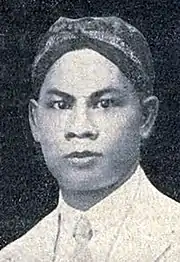Oto Iskandar di Nata | |
|---|---|
 | |
| State Minister of Indonesia | |
| In office 19 August 1945 – 14 November 1945 | |
| President | Sukarno |
| Personal details | |
| Born | 31 March 1897 Bodjongsoang, Bandoeng, Dutch East Indies |
| Disappeared | 19 December 1945 (aged 48) Tangerang, West Java, Indonesia |
| Status | Retrospectively declared dead in absentia on 20 December 1945 (aged 48) on 6 November 1973 |
Oto Iskandar di Nata (Sundanese: ᮛ᮪ᮓ᮪. ᮇᮒ᮪ᮒᮧ ᮄᮞ᮪ᮊᮔ᮪ᮓᮁᮓᮤᮔᮒ, also spelled Otto Iskandardinata, called Otista and nicknamed Si Jalak Harupat; born 31 March 1897 – disappeared 19 December 1945, retrospectively declared dead 20 December 1945) was an Indonesian politician and National Hero.
Work
In his activities during the period before independence, Oto had served as Deputy Chairperson of the Bandung branch of Budi Utomo between 1921 and 1924, as well as Deputy Chairperson of Budi Utomo in Pekalongan branch in 1924. At that time, he became a member of Pekalongan's Gemeenteraad ("City Council") representing Budi Utomo.[1]
Oto was also active in Sundanese cultural organizations called Paguyuban Pasundan. He became Secretary of the Executive Board in 1928, and became chairman between 1929 and 1942. The organization is engaged in education, socio-cultural, political, economic, youth and women's empowerment.[2]
Oto also became a member of the Volksraad ("People's Council", equivalent to present-day DPR) between 1930 and 1941.[3]
During the Japanese occupation of the Dutch East Indies, he became the head of the Tjahaja newspaper. He was also appointed to the Javanese Central Advisory Council, also set up the occupation government, and later became a member of the Investigating Committee for Preparatory Work for independence (BPUPK) and the Preparatory Committee for Indonesian Independence (PPKI) formed by the Japanese Sixteenth Army to help prepare for Java's independence.[3][4][5]
Disappearance
Based on witness information, Oto is believed to have been murdered on a beach in Mauk District, Tangerang Regency in Banten (formerly West Java). He was abducted by a group called "The Black Troop" (Indonesian: Laskar Hitam), who killed him and dumped his body into the sea; the body was never found.[6][7] In 1959 a policeman was charged and convicted of the murder itself. The prosecutor who located the policeman asked to investigate further to determine the larger political objectives and members of the "Black Troop", but this request was not heeded, so the true circumstances of his murder remain unclear.
Aftermath and legacy

On 21 December 1952, his funeral was held in absentia. His body was replaced by sand and water taken from the beach, and interred in a cemetery in Lembang, now of West Bandung Regency. He was designated as a National Hero of Indonesia on 6 November 1973, thus legally declaring him dead, as the title is awarded posthumously.
His image appears on the 2004–2016 series of the 20,000 Indonesian rupiah note. His name is now used as street name in various cities in Indonesia on different formats; Otto Iskandardinata, Otto Iskandar Dinata, Otista, and Jalak Harupat. The latter is a Sundanese-mythical strong and courageous cock. It is used as name for Jalak Harupat Stadium, located in his hometown.
He had twelve children.[8] One, Ratnati Soertiasih (1939–1998[9]), was briefly an exchange student in the United States.
See also
References
- ↑ Enam fakta Oto Iskandar di nata yang tersembunyi ayobandung.com. Retrieved 2 October 2018
- ↑ "Generasi Muda Sunda Diminta Kenali Oto Iskandar Di Nata". Republika (in Indonesian). 18 December 2017. Retrieved 2 October 2018.
- 1 2 "Menguak Rahasia Oto Iskandar Di Nata". Pikiran Rakyat. 16 December 2017. Retrieved 2 October 2018.
- ↑ Kusuma, A.B (2004). Lahirnya Undang-Undang Dasar 1945 : memuat salinan dokumen otentik badan oentoek menyelidiki oesaha2 persiapan kemerdekaan [The Birth of the 1945 Constitution: including copies of the authentic documents of the Investigating Committee for Preparatory Work for Independence] (in Indonesian). Depok, Indonesia: Badan Penerbit Fakultas Hukum Universitas Indonesia. p. 21. ISBN 979-8972-28-7.
- ↑ Kusuma, A.B.; Elson, R.E. (2011), "A note on the sources for the 1945 constitutional debates in Indonesia" (PDF), Bijdragen tot de Taal-, Land- en Volkenkunde, 167 (2–3): 196, doi:10.1163/22134379-90003589, ISSN 0006-2294
- ↑ Susmana, A. J. (10 January 2016). "Kematian Oto Iskandar Di Nata 70 Tahun Lalu" [The Death of Oto Iskandar di Nata 70 Years Ago] (in Indonesian). Retrieved 26 February 2019.
- ↑ Adam, Asvi Warman (17 February 2014). "Tomb of Tan Malaka, Finally". The Jakarta Post. Retrieved 23 September 2018.
- ↑ Lubis, Nina H. (2003). Si Jalak Harupat: biografi R. Oto Iskandar di Nata, 1897-1945. Jakarta: Gramedia Pustaka Utama. ISBN 9789792202663.
- ↑ "Makam Giritama". makamgiritama.com.